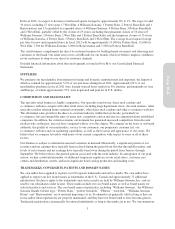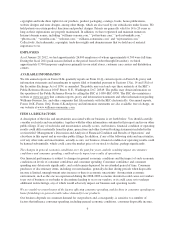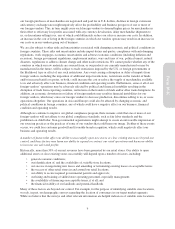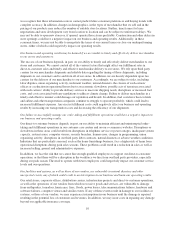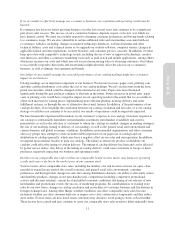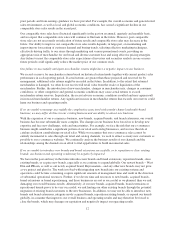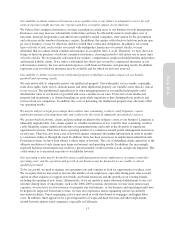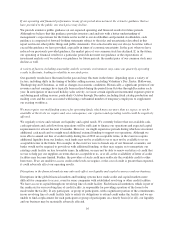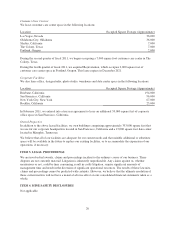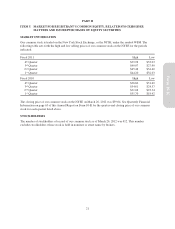Pottery Barn 2011 Annual Report Download - page 25
Download and view the complete annual report
Please find page 25 of the 2011 Pottery Barn annual report below. You can navigate through the pages in the report by either clicking on the pages listed below, or by using the keyword search tool below to find specific information within the annual report.
If we are unable to effectively manage our e-commerce business, our reputation and operating results may be
harmed.
E-commerce has been our fastest growing business over the last several years and continues to be a significant
part of our sales success. The success of our e-commerce business depends, in part, on factors over which we
have limited control. We must successfully respond to changing consumer preferences and buying trends relating
to e-commerce usage. We are also vulnerable to certain additional risks and uncertainties associated with our
e-commerce websites, including: changes in required technology interfaces; website downtime and other
technical failures; costs and technical issues as we upgrade our website software; computer viruses; changes in
applicable federal and state regulations; security breaches; and consumer privacy concerns. In addition, we must
keep up to date with competitive technology trends, including the use of new or improved technology, creative
user interfaces and other e-commerce marketing tools such as paid search and mobile applications, among others,
which may increase our costs and which may not succeed in increasing sales or attracting customers. Our failure
to successfully respond to these risks and uncertainties might adversely affect the sales in our e-commerce
business, as well as damage our reputation and brands.
Our failure to successfully manage the costs and performance of our catalog mailings might have a negative
impact on our business.
Catalog mailings are an important component of our business. Postal rate increases, paper costs, printing costs
and other catalog distribution costs affect the cost of our catalog mailings. We rely on discounts from the basic
postal rate structure, which could be changed or discontinued at any time. Paper costs have fluctuated
significantly during the past and may continue to fluctuate in the future. Future increases in postal rates, paper
costs or printing costs would have a negative impact on our operating results to the extent that we are unable to
offset such increases by raising prices, implementing more efficient printing, mailing, delivery and order
fulfillment systems, or through the use of alternative direct-mail formats. In addition, if the performance of our
catalogs declines, if we misjudge the correlation between our catalog circulation and net sales, or if our catalog
strategy overall does not continue to be successful, our results of operations could be negatively impacted.
We have historically experienced fluctuations in our customers’ response to our catalogs. Customer response to
our catalogs is substantially dependent on merchandise assortment, merchandise availability and creative
presentation, as well as the selection of customers to whom the catalogs are mailed, changes in mailing strategies,
the size of our mailings, timing of delivery of our mailings, as well as the general retail sales environment and
current domestic and global economic conditions. In addition, environmental organizations and other consumer
advocacy groups may attempt to create an unfavorable impression of our paper use in catalogs and our
distribution of catalogs generally, which may have a negative effect on our sales and our reputation. In addition,
we depend upon external vendors to print our catalogs. The failure to effectively produce or distribute our
catalogs could affect the timing of catalog delivery. The timing of catalog delivery has been and can be affected
by postal service delays. Any delays in the timing of catalog delivery could cause customers to forego or defer
purchases, negatively impacting our business and operating results.
Declines in our comparable store sales within our comparable brand revenue metric may harm our operating
results and cause a decline in the market price of our common stock.
Various factors affect comparable store sales, including the number, size and location of stores we open, close,
remodel or expand in any period, the overall economic and general retail sales environment, consumer
preferences and buying trends, changes in sales mix among distribution channels, our ability to efficiently source
and distribute products, changes in our merchandise mix, competition (including competitive promotional
activity and discount retailers), current local and global economic conditions, the timing of our releases of new
merchandise and promotional events, the success of marketing programs, the cannibalization of existing store
sales by our new stores, changes in catalog circulation and in our direct-to-customer business and fluctuations in
foreign exchange rates. Among other things, weather conditions can affect comparable store sales because
inclement weather can alter consumer behavior or require us to close certain stores temporarily and thus reduce
store traffic. Even if stores are not closed, many customers may decide to avoid going to stores in bad weather.
These factors have caused and may continue to cause our comparable store sales results to differ materially from
11
Form 10-K






